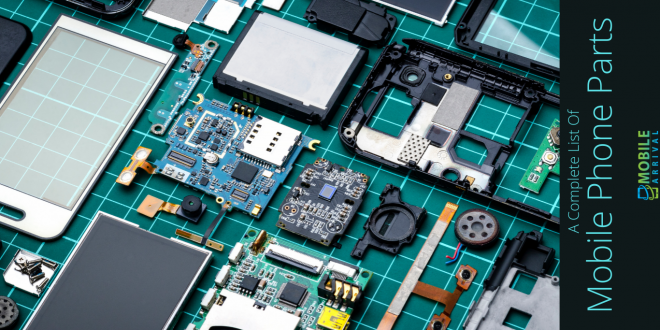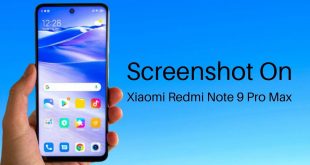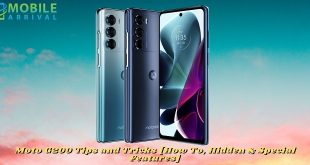Are you searching for mobile phone parts? A trustworthy mobile technician must know all about fundamental mobile phone parts, their names, also their functionalities.
Discover all components and mobile phone parts that make up a mobile device’s P.C.B. and its functions.
Mobile Phones contain a variety of parts, whether they are Feature Phones or Android Smartphones.
All Mobile Phones from Samsung, Nokia, Apple, Z.T.E., Vivo, Xiaomi, Z.T.E., Z.T.E., HUAWEI, AMD, Blackberry, Acer, Alcatel, Asus, BenQ, Siemens, OnePlus, Oppo, Xiaomi, Blackberry.
Parts for these machines can be purchased online as well as offline.
Contents
- 40 most common mobile phone parts and their functionalities are listed below:
- 1. Antenna
- 2. R.X. filter & TX filter
- 3. Battery
- 4. Battery Charger
- 5. Random Access Memory (RAM)
- 6. Reading-only memory (R.O.M.)
- 7. The visual display
- 8. Key or switch tip
- 9. Processor (CPU)
- 10. Voltage-controlled oscillator (VCO)
- 11. I.C. for audio
- 12. Module with Universal Energy (UEM IC)
- 13. Antenna Switch
- 14. IF IC
- 15. Ear Speaker
- 16. Microphone
- 17. The L.E.D. (light-emitting diode) is a type of light source.
- 18. RF Crystal
- 19. Socket for SIM cards
- 20. Memory Card
- 21. Vibrator Motor
- 22. SIM card
- 23. P.F.O.
- 24. Antenna socket for external antennas
- 25. RETU IC
- 26. TAHVO IC
- 27. OMAP Module
- 28. Connector with hands-free functionality
- 29. Flash I.C.
- 30. R.A.P. 3G IC
- 31. USB Connector
- 32. JoyStick
- 33. Software Connector Parts
- 34. Cards: AVILMA IC, BETTY IC, UIM Card
- 35. Digitizer Assemblies
- 36. MHz Crystal Oscillator
- 37. VCO
- 38. Connector Tip
- 39. Testing Points
- 40. LTR
- What Are the Benefits of Repairing Your Mobile Phone?
40 most common mobile phone parts and their functionalities are listed below:
1. Antenna
In radio frequency communication, antennas are used to receive and transmit signals. Also, the GPS units are integrated into mobile phones. They are antennas built into the phone.
2. R.X. filter & TX filter
R.X. filter:
Mobile phones transmit their frequency to the cell phone while this part of the Phone filters incoming calls. You will find it in the Phone’s network settings. A faulty network adapter will cause an incoming call to have network problems.
Tx filter:
Cell phone components that filter mobile phone frequency during outgoing calls. Cell phone components that filter mobile phone frequency during outgoing calls. The incoming call will have network problems due to a faulty device.
3. Battery
Mobile phones receive all of their power from the battery. There are three types of batteries most commonly used in cell phones and tablets:
- Nickel NI-CD –(Nickel – Cadmium)
- Ni – MH — (Nickel Metal Hydride)
- (Li-Ion) —- Lithium-Ion battery.
4. Battery Charger
Cell phone batteries are recharged with chargers of several types. Battery chargers, Travel Adaptors (T.A.), also, the Cigar Lighter Adapters (C.L.A.) are examples.
5. Random Access Memory (RAM)
Objects can be written to RAM, and old data can be erased or replaced with new data.
6. Reading-only memory (R.O.M.)
Unlike writeable memories, read-only memories cannot be written to. The data is irreversible. Also, a pseudo-programmable R.O.M. (PROM) can be programmed or erased and erasable R.O.M. (EROM).
7. The visual display
It generates light for displaying all the information on the Phone. The following are the types of displays seen on cell phones:
- LCD (Liquid Crystal Displays)
- Fluorescent vacuum display (V.F.D.)
- Displays using thin-film transistors (T.F.T.).
8. Key or switch tip
A keypad is made up of these tiny switches.
9. Processor (CPU)
An iPhone, Android Smartphone, and a mobile phone use a CPU as their primary control system. Also, the processor controls all processing and functions.
10. Voltage-controlled oscillator (VCO)
This parameter controls the frequency.
11. I.C. for audio
This I.C. controls audio frequency, and sound is produced.
12. Module with Universal Energy (UEM IC)
It has several functions as a power supply, charger, audio processor, ringer, and vibrator.
13. Antenna Switch
This device receives, transmits, and switches frequencies like GSM, D.C.S., and P.C.S.
14. IF IC
This I.C. is also known as Hager IC, Molner IC, and RF IC. It functions as an amplifier, mixing, and demodulator.
15. Ear Speaker
Mobile phones are equipped with an ear speaker attached to the top. During incoming calls, you can listen to the sound.
16. Microphone
During transmission, it converts voice signals into electrical signals or tone signals. An audio I.C. receives this signal.
17. The L.E.D. (light-emitting diode) is a type of light source.
Light is produced on the keyboard and displayed by this component.
18. RF Crystal
Any mobile phone is not complete without this crystal. Phones use crystals with frequencies ranging from 13 MHz to 36.4 MHz. If the crystal fails, the Phone becomes unusable.
19. Socket for SIM cards
Using the SIM card stick, also the SIM card is held in place and can be read or written to.
20. Memory Card
An external memory card is a storage device for storing photos, videos, audio, etc. As well as the external memory cards include S.D. cards, Mini SD cards, and Micro SD cards.
21. Vibrator Motor
It provides vibrating alerts when incoming calls or messages are received when you are in silent mode or have the option turned on.
22. SIM card
Subscriber Identity Module is also known as SIM. The GSM mobile phone uses this technology. The card contains a microchip that stores all information and data related to the USER. An unlocked GSM phone is of no use without a SIM Card.
23. P.F.O.
As an amplifier or bandpass filter, it is found in network sections near the antenna switch. The filter and amplifier amplify also the frequency of the network.
An erroneous PCO will result in
- There is no mobile network
- Network problems on mobile devices
- Your mobile phone may be dead due to a P.F.O. short-circuit
- The trouble with other networks
24. Antenna socket for external antennas
Accessories can be attached to this socket to allow external antennas to be connected. An increased range of the internal antennas is achieved with this.
25. RETU IC
This module performs several essential functions.
26. TAHVO IC
This module performs several other functions.
27. OMAP Module
Applications software is processed, and U.I. software is controlled.
28. Connector with hands-free functionality
Utilizing a Headset or Earphone, you can keep in touch without touching the Phone.
29. Flash I.C.
Programs are stored in this memory, and non-volatile data is stored in this memory.
30. R.A.P. 3G IC
With this I.C., SD-RAM memory modules and non-Flash memory modules were combined in the modem section. Also, the cellular protocol used by Rap3G works with GSM and WCDMA.
31. USB Connector
Data can be downloaded, and the Phone can be charged through a USB Connector essential mobile phone part.
32. JoyStick
A user interface is used to make the process easier. Also, the function of the joystick can be set to control the operation of the cell phone.
33. Software Connector Parts
Software or operating systems can be flashed with this tool. To resolve software problems, a computer and phone can be connected through this connector.
34. Cards: AVILMA IC, BETTY IC, UIM Card
There are a few other Mobile phone parts that are not very common.
35. Digitizer Assemblies
LCD screens themselves do not usually fall into this category, but their glass covers do. By translating manual actions into signals that the mobile device can interpret, also digitizers enable you to swipe, tap, etc. Connecting the Phone’s heart to the digitizer is usually done with a Flex cable.
36. MHz Crystal Oscillator
Most mobile phones have a metal P.C.B. with this component located near the P.F.O. Also, outgoing calls are generated by a crystal oscillator, which filters the network. Additionally, the network and incoming calls will be impacted if it malfunctions.
37. VCO
The network section contains this device that sends data voltage to the CPU and RF IC. Once the CPU commands the VCO, it is its responsibility to set the frequency.
Any fault occurring in VCO will disrupt your Phone’s network, causing it to display the message “Call failed” or “Call ended.”
38. Connector Tip
The speaker, ringer, vibrator, and antenna are all interconnected with this device.
39. Testing Points
Mobile phone part C.R.O. is used to check the outputs of various signals coming from these tips.
40. LTR
One of the most important mobile phone parts is LTR. Voltage is regulated with this regulator.
What Are the Benefits of Repairing Your Mobile Phone?
The following three benefits are offered;
Lower Cost Of Mobile Phone Components
Repairing your Phone can result in considerable savings since you’re not paying for services you don’t need. When your phone is repaired, you pay primarily for the labor.
Replacing the components themselves is usually relatively inexpensive. Eliminating labor will therefore allow you to save a significant amount of money.
Saves time
A mobile phone without service for days or even weeks is a foreign concept to many people. Therefore, a mobile phone repair specialist is the only way to solve this problem.
It doesn’t matter whether you mail in your smartphone or send it to a local repair shop. Also. you could go weeks without a phone for repairs that should only take an hour or two.
It will be possible for you to keep your Phone throughout the process and get it fully working again as soon as possible if you can obtain the parts needed for your repair.
The Repair Process Is De-Mystified With Several Tutorials
In addition, D.I.Y. phone repair is highly viable nowadays due to the proliferation of tutorials.
It shouldn’t be too challenging to repair your Phone despite your level of experience. Most major phone manufacturers offer instructions and resources.
Final thoughts
We try to list all the most common mobile phone parts in the market nowadays. I hope you like Our article regarding the mobile phone part.
Let us know in the comment section if you have any questions about the mobile phone section and wish to add any other parts to it.
F.A.Q.s:
Customers generally are satisfied with MobileSentrix, as indicated by its 3.52 out of 5-star customer rating. As of November 2016, MobileSentrix ranked 26th.
The RAM must be sufficient to support multitasking. The essential functions of operating systems and games require a bit of memory to run. You can run more apps on your phone if you have more memory. The default for everyday tasks is 2 G.B. of RAM or more.
All mobile phones contain I.C.s, which are known as integrated circuits and are micro-chips.
The screen of your Phone can be replaced by yourself. Those of you who are willing to fix their phones themselves are likely not too concerned about maintaining your warranty. However, knowing whether you will void it won’t hurt.
 Mobile Arrival Smartphones and gadget reviews, news and more.
Mobile Arrival Smartphones and gadget reviews, news and more.







